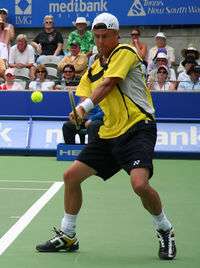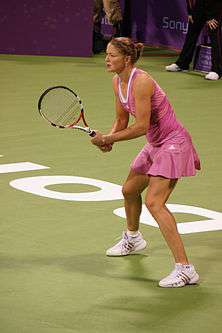Brisbane International
Coordinates: 27°31′30.12″S 153°0′26.06″E / 27.5250333°S 153.0072389°E
| Brisbane International | |||||||||
|---|---|---|---|---|---|---|---|---|---|
 | |||||||||
| Tournament information | |||||||||
| Event name | Brisbane International | ||||||||
| Location |
Adelaide, SA (1972–2008) Brisbane, Queensland (2009–) | ||||||||
| Venue | Queensland Tennis Centre | ||||||||
| Surface | Plexicushion | ||||||||
| Website | brisbaneinternational.com.au | ||||||||
| |||||||||
| |||||||||






The Brisbane International is a professional tennis tournament played on outdoor hard courts in Brisbane, Queensland. It is part of the ATP World Tour 250 series of the Association of Tennis Professionals (ATP) World Tour and of the WTA Premier tournaments of the Women's Tennis Association (WTA) Tour. It is held annually in January at the Queensland Tennis Centre just before the first Grand Slam tournament of the season, the Australian Open as part of the Australian Open Series. It is owned by Tennis Australia.
History
The origins of the Brisbane International trace back to the early 1970s, when the Grand Prix tennis circuit, formed in 1970, and which ran concurrently with other tours as the World Championship Tennis circuit, decided to feature on its calendar an event in Queensland to develop a South West Pacific season around the Australian Open - then taking place in Brisbane - alongside other Oceanian events of Sydney, New South Wales; Hobart, Tasmania; and Auckland, New Zealand. The Adelaide-based South Australian Tennis Championships, running as an amateur, then as a State championship, since 1889, were brought to the professional circuit in 1972. The first professional edition of the men's event, played, like the Australian Open, on outdoor grass courts, saw the victory of Soviet Alex Metreveli over Kim Warwick, while the women's event, still not featured in either the Commercial Union Grand Prix circuit or the Virginia Slims circuit, saw Australian Evonne Goolagong win the title.[1]
The tournament had a chaotic history over the following years, taking place on the professional tour again in 1974, in 1977, as the Marlboro-sponsored South Australian Men's Tennis Classic,[2] and in 1979, as the South Australian Open,[3] before it started a regular run in 1981 under the latter title. Moved from January to December in the Grand Prix circuit calendars of the early 1980s, the South Australian Open sealed its place as the opening event of the season in 1987, when it was scheduled again in January, following the return of the Australian Open as the first Grand Slam event of the year. After the surface change of the Australian Open, the tournament also switched to hard courts, starting with the 1988 edition. During the 1980s, the event saw the victories of Australian players as Wally Masur, Mark Woodforde, Mark Kratzmann or Darren Cahill. The taking over of the tour's organization in 1990 by the Association of Tennis Professionals led to several changes, when the tournament, an ATP World Series event, became the Australian Men's Hardcourt Championships, and the prize money increased from $93,000 to $125,000.
In 1997, the Corel WTA Tour created a new event –played on outdoor hardcourts– in Gold Coast, Queensland.[4] The Tier III Gold Coast Classic was added the three preexisting tournaments of Auckland, Sydney and Hobart, and became one of the two events held in the first week of the women's calendar, parallel to the men's Adelaide tournament. Various players, among which Ai Sugiyama, Justine Henin, Patty Schnyder or Venus Williams found success over the years at the low tier tune-up event for the Australian Open. The Gold Coast Classic became the Thalgo Australian Women's Hardcourts in 1998, took the sponsorship of Uncle Tobys in 2003, becoming Uncle Tobys Hardcourts, and changed names again in 2006 to Mondial Australian Women's Hardcourts.[4]
Meanwhile, the ATP International Series Adelaide, which had evolved into the AAPT Championships in 1999, Next Generation Hardcourts in 2005, and Next Generation Adelaide International in 2006 had become one of the three stops of the calendar's first week, alongside the Qatar Open of Doha, Qatar, and the Chennai Open of Chennai, India. Many popular players added their names to the honor roll in the 1990s and the early 2000s, with Thomas Muster, Goran Ivanišević, Jim Courier, Lleyton Hewitt, Tommy Haas, Tim Henman, Nikolay Davydenko or Novak Djokovic winning the singles - and Todd Woodbridge and Mark Woodforde, Bob and Mike Bryan, Jonathan Erlich and Andy Ram reaching the doubles finals.
As both the men's and the women's tour calendars were to undergo important changes from 2008 to 2009, with the WTA inaugurating its new roadmap of International and Premier tournaments, and the ATP Tour becoming the ATP World Tour, with new Masters 1000, 500 and 250 events, it was decided in 2006 to merge the Next Generation Adelaide International and the Mondial Australian Women's Hardcourts into a larger ATP-WTA joint tournament in Brisbane, leading, similarly to the joint Medibank International Sydney, to the Australian Open.[5] Tennis Australia chief Steve Wood commented on the shift: "One of the reasons we are doing this is that there's a rise of more lucrative overseas tournaments in the lead-up to the Australian Open offering increasingly attractive alternatives to the top players looking to prepare for the first Grand Slam. [...] So we really wanted them to invest in having them continue to prepare here in Australia, on the road to the Australian Open."[5] The first Brisbane International took place in Brisbane's newly built Tennyson Tennis Centre – and its Patrick Rafter-named Centre Court – in January 2009.[6][7] In time for the 2012 event the tournament was promoted to a premier event on the WTA tour.[8]
Past finals
In the men's singles, Lleyton Hewitt (1998, 2000, 2014) holds the record for most titles with three. Mike Bauer (1982–83), Mark Woodforde (1988–89), Nicklas Kulti (1991, 1993), Yevgeny Kafelnikov (1994, 1996) and Andy Murray (2012–13) each have two titles. Bauer, Woodforde and Murray co-hold the record for most consecutive titles. Hewitt alone holds the record for most finals with four (1998–2000, 2014).
In the women's singles, Ai Sugiyama (1998, 2004), Patty Schnyder (1999, 2005), Victoria Azarenka (2009, 2016) and Serena Williams (2013, 2014) share the record for most titles with two. Azarenka has the record for most finals appearances (2008–09, 2014, 2016).
Men's singles
Women's singles
Men's doubles
Women's doubles
References
- ↑ "Miss Goolagong Voted Woman Athlete of Year". The New York Times. Associated Press. 1972-01-22. Retrieved 2008-10-20.
- ↑ "Teacher and Pasarell Gain Aussie Semifinals". The New York Times. United Press International. 1977-01-16. Retrieved 2008-10-20.
- ↑ "Warwick Tops Mitton, 7-6, 6-4". The Hartford Courant. Associated Press. 1979-12-17. Retrieved 2008-10-20.
- 1 2 "Sony Ericsson WTA Tour Final Results: 1971-2007" (PDF). sonyericssonwtatour.com. Archived from the original (PDF) on December 18, 2008. Retrieved 2008-12-25.
- 1 2 Pearce, Linda (2006-07-08). "Adelaide event shifts to Brisbane". theage.com.au. Retrieved 2008-12-25.
- ↑ "atpworldtour.com Brisbane International profile". atpworldtour.com. Retrieved 2008-12-25.
- ↑ "sonyericssonwtatour.com Brisbane International profile". sonyericssonwtatour.com. Archived from the original on January 16, 2009. Retrieved 2008-12-25.
- ↑ http://www.worldtennismagazine.com/archives/4513
External links
| Wikimedia Commons has media related to Brisbane International. |